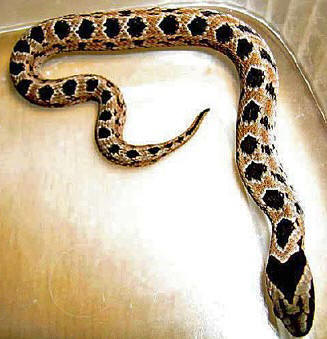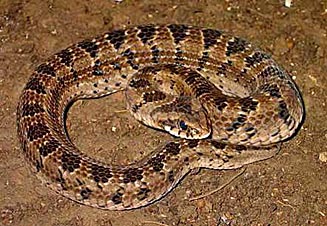|
Causus rhombeatus (Rhombic night adder or Common night adder)
Nagadder [Afrikaans]; iNyoka yasebusuku [Zulu]; Unomofuthwana
[Xhosa]; Changwa [Ndebele]; Chiva [Shona].
Life >
Eukaryotes
>
Opisthokonta >
Metazoa
(animals) > Bilateria > Deuterostomia >
Chordata >
Craniata > Vertebrata (vertebrates) > Gnathostomata (jawed vertebrates) >
Teleostomi (teleost fish) > Osteichthyes (bony fish) > Class:
Sarcopterygii (lobe-finned fish) > Stegocephalia (terrestrial vertebrates) >
Tetrapoda
(four-legged vertebrates) > Reptiliomorpha > Amniota >
Reptilia (reptiles) >
Romeriida > Diapsida > Lepidosauromorpha > Lepidosauria >
Squamata > Serpentes
(snakes) > Family: Viperidae > Genus: Causus
 |
 Causus rhombeatus
(Rhombic Night adder or Common Night adder), KwaZulu-Natal [C. Dorse & S. Van
Rooyen © from
SARCA
Virtual Museum]
|
|
Causus rhombeatus (Rhombic Night adder or Common Night adder),
KwaZulu-Natal [P.Vos © from
SARCA
Virtual Museum] |
|
Identification
Can be identified by its grey, olive or brown colour, its
rhombic (diamond shaped markings), its slightly keeled (rough) scales and the
distinctive V-marking on its head. This snake has an average length of 60 cm but
may reach up to 1 meter in length.
Distribution and habitat
The Rhombic Night adder is found all along South Africa's
east coast (except for the Western cape). It is also present in Mpumalanga,
Gauteng, Limpopo and the Free State (only a very small isolated population).
This snake has also been found in Swaziland, Mozambique, Zimbabwe and on the
border of Botswana and Namibia (in the Caprivi strip). This snake is often found
in moist savanna, lowland forest and fynbos; These areas are favoured because the
are relatively damp and have high concentrations of the snakes prey.
Food
Feeds on
amphibians
(particularly
rain
frogs),
tadpoles and
insects.
Predators, parasites and disease
This snake species is fed on by other snakes, monitor
lizards and
birds of
prey (particularly
secretary birds and
snake eagles).
Reproduction
Oviparous (egg laying), lays between 7 and 26 eggs and
often lays 2 or 3 batches per year.
Longevity
This snake has an average lifespan of 10 years.
Medical importance
This adder species has a mild cytotoxic venom which although non
lethal can cause tissue damage. There is an antivenom available but it is seldom
required, in spite of this the venom is harmful and the situation should still
be monitored.
Links
References
-
Broadley, D.G. 1983. FitzSimons' Snakes of Southern
Africa. Delta Books, Johannesburg.
-
Marais, J. 2004. A Complete Guide to Snakes of Southern Africa.
Struik Publishing, Cape Town.
|
